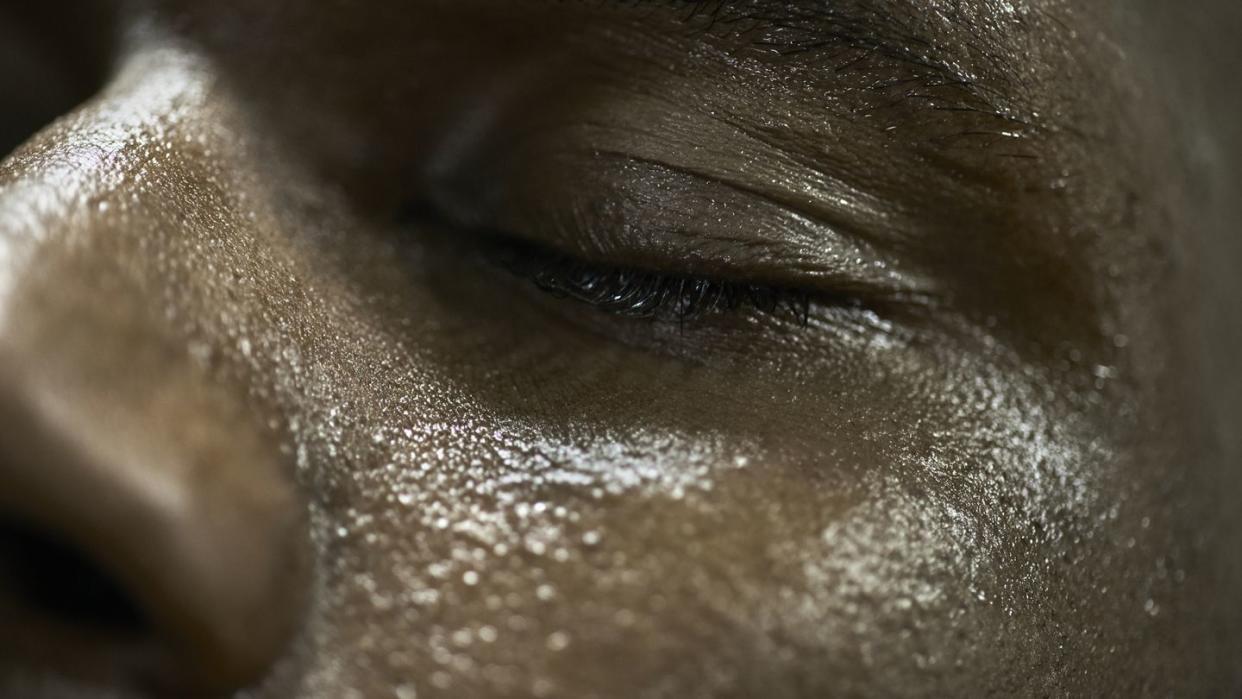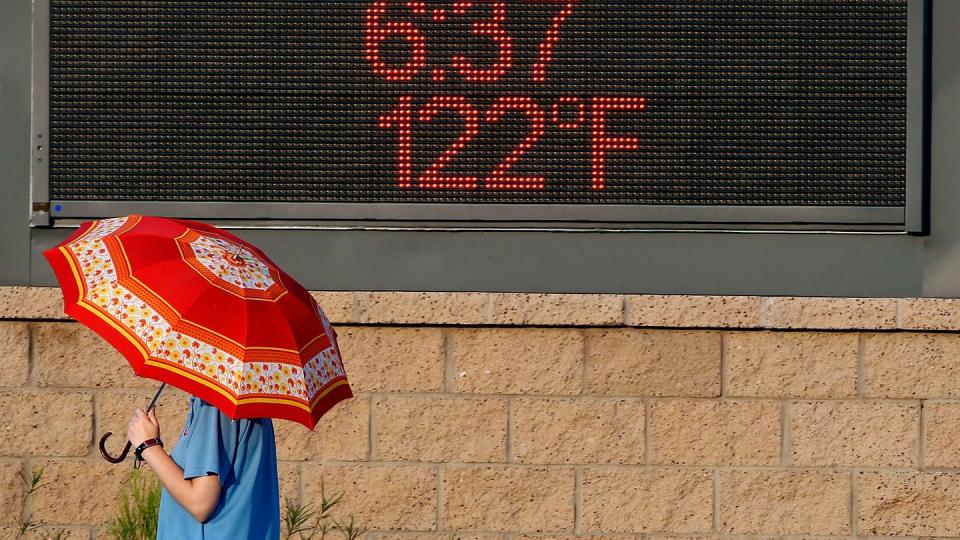The Hottest Temperature A Human Can Survive Is Much Lower Than You Think

"Hearst Magazines and Yahoo may earn commission or revenue on some items through these links."
In Andy Weir’s 2021 novel Project Hail Mary, the dimming of the sun by 5 to 10 percent is enough to cause a collapse of the entire global ecosystem and food chain. Earth’s governments act with urgency to make and send a spacecraft to save humanity. This seems more fictional than ever when politics take precedent over the science of climate change, with even the U.S. going back and forth on the Paris Accord.
In the era of human-caused climate change, you may be used to seeing headlines and news stories about what will happen to the ice caps and lower-lying land areas around the world. There are new or expanding diseases because of microscopic pathogens that emerge or thrive in the warming climate. And more places around the world are experiencing more severe storms.
But what about the human body itself? We take hot baths, play sports outside on hot days, and even live in the hottest climates on Earth. At the same time, hot weather is a killer: The EPA says there were 11,000 deaths in the U.S. directly caused by heat exposure between 1979 and 2018, and likely more where it was not listed or understood as the cause of death.
What does extreme heat do to your body?
Inside our bodies, there are multiple reasons hot weather can be deadly. Heat exhaustion and heat stroke are serious conditions caused by heat, and these can be fatal on their own. Heat is also an exacerbating factor for certain preexisting conditions or cardiovascular diseases, the category that includes strokes and heart attacks. And there’s a separate form of heat stroke that affects athletes, because the way exercise works in the body can become a runaway heating process that must be stopped by medical professionals.
The major way heat causes injury to the body is through water. The body’s water equilibrium is precise and temperamental, and it’s highly exposed to the surrounding air through our skin and respiration. In hot weather, and especially hot and dry weather, water can evaporate from the skin and through respiration so rapidly that it can’t be replaced in time. Evaporating sweat cools the body, but too much water lost through sweating leads to dehydration.
Did you know? Extreme heat is the leading cause of weather-related deaths in the U.S. According to data from the CDC, “heat has caused more U.S. deaths yearly than hurricanes and tornadoes combined on average over the past thirty years.”
That water equilibrium is vital to how our organs and even our individual cells work. Without enough water in the body, we begin to lose blood volume, for example, which can strangle our organs and cause damage or failure. Cells can also die. There is just no longer the right volume to optimally circulate and bring fresh and vital oxygen, which these organs use as fuel. That’s why the risk of cardiovascular disease rises in the heat.
The body’s temperature itself is affected by blood circulation. Having impaired blood circulation is like running your car’s engine when the oil has drained out. Blood circulation is one of the major ways the inside of the body stays at the right temperature, and one of the only ways it is able to do that. When we breathe in, the air is almost always a cooler temperature than the inside of our bodies, and that cools the blood as it spreads out into the lungs for oxygenation.
What’s the hottest temperature a human can survive?
Externally, the upper limit of the human body’s thermoneutral zone—the ambient temperature range in which the body can effectively maintain its temperature and equilibrium—likely falls somewhere between 104 and 122 degrees Fahrenheit, according to a 2021 study published in Physiology Report. Once the air temperature hits 122 degrees, our bodies can no longer dissipate heat and our core temperature rises. But another study cites a much lower limit of 89.6 degrees—the temperature at which humans start sweating. Beyond air temperature, humidity plays a big role too, and the higher the humidity the harder our bodies have to work to stay cool.
The limits for internal body temperature are even more restrictive. According to MedlinePlus, brain damage can occur once the body reaches an internal temperature of 107.6 degrees Fahrenheit. A 2022 Outside article on heat stroke cites the highest known body temperature that a human was able to survive: “The highest body temperature measured was only 17 degrees above normal. Willie Jones, a 52-year-old Atlanta man, was rescued from his apartment during a heat wave in 1980. His internal temperature was 115.7.”
What about extreme cold? According to that same Outside article, “The lowest body temperature a human has been known to survive is 56.7 degrees [Fahrenheit], nearly 42 degrees below normal.”
This makes intuitive sense, now that we understand the effects of heat on evaporation rates. As body temperature grows colder, it causes different problems, but does not lead to dehydration. In fact, medical researchers are exploring a new technology called emergency preservation and resuscitation, where patients are cooled intravenously down to 50 degrees Fahrenheit in order to slow severe blood loss while they undergo emergency surgery for traumatic injury.
Cold temperatures slow the blood, which can cause more severe cold weather injuries like frostbite. Without blood to warm the tissue, it freezes, and those ice crystals damage the cells and tissue.

How should I handle extreme heat?
There isn’t a lot people can do to accommodate extreme temperatures, besides staying hydrated, including with electrolytes if needed. The body sweats out a lot of salt and minerals, and if you drink a lot of water but don’t replace these depleted minerals, the body can experience other complications. And the CDC recommends doing everything you can to reduce the temperature in your location, like taking cool baths, eating cold foods, and wearing lighter-weight clothes.
One counterintuitive but vital piece of advice is that an electric fan does not stop heat-related illness. In fact, because of the way evaporation works, someone could become more dehydrated in a space with a running fan compared with a space the same temperature without it. Wind carries away water vapor more quickly, because the heavier water particles themselves can be moved by the wind.
As the climate warms, people will need to adapt in order to survive. This year, residents of Phoenix, Arizona, experienced 31 days in a row of highs at or above 110 degrees Fahrenheit. That’s in a 12-month period—the hottest ever recorded for the entire planet. As climate change continues, especially without efforts by the world’s governments to counteract it, more people will become climate refugees. Some places, like Arizona, may become uninhabitable altogether.
Other people may become more migratory, like the fictional characters in Ursula K. Le Guin’s 2002 story The Seasons of the Ansarac:
“But some people linger in the city till it is almost empty, and still can’t make up their mind to leave the hot and silent streets, the sad, shadeless, deserted squares, that were so full of crowds and music all through the long halfyear. But first and last they all set out on the roads that lead north. And once they go, they go with speed.”
It’s hard to imagine a way in which the human body will adapt to the simple, biological facts of heat and evaporation. Our bodies rely on maintaining a very precise equilibrium, and the outcomes from extreme heat could become the next mass extinction event for living things on Earth. It’s time to “go with speed” in our efforts to halt and reverse climate change.
You Might Also Like

